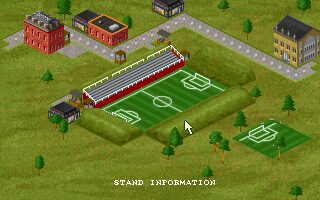
Author: Tasha - Published: 4 July 2017, 1:28 am
Ultimate Soccer Manager is a managerial soccer game developed and published by Impressions in 1995 for DOS and Amiga. It was designed by David Lester and Neal Sumsion.
The game is played by interacting with the world, clicking on the different buildings to access their options, or clicking on the items in your office (filing cabinet, tv, etc.). You take control of your own field and team in this business simulation. Obviously the goal is to have a successful and money making stadium/team. You control everything from ticket prices to advertising to players. You can also purchase many improvements for your field grounds to make those high ticket prices worth it. Buy and sell players as your leisure as well as change their names. When actually playing soccer you see the field from above and you can even micromanage the game while it's being played. Speed it up, slow it down, or substitute players. You can also bet on and fix the games if you so choose.
Read More
Author: GN Team - Published: 1 July 2017, 9:37 pm
Merchant Colony is a trading strategy/simulation game during the colonial age (18th century) designed by David Lester. It was published by Impressions in 1991 for DOS, Amiga, and Atari ST.
The year is 1700, and you are a merchant prince who wants to build up his trading company. You can explore the world and build new colonies you must manage and defend with your soldiers. When they can sustain themselves, they will eventually produce surplus goods you can sell. Of course, you will need ships to sell and make money traveling the world.
Read More
Author: GN Team - Published: 30 June 2017, 11:15 pm
Detroit is a turn-based managerial strategy game developed by Impressions Games and released for PC and Amiga, including an AGA version, in 1994.
The title was designed by David Lester, the author of Caesar and Lords of the Realm.
Detroit is set in 1908 and just like Henry Ford, you have the chance to start your car building company. Your tasks will include designing, marketing, and selling your own cars. You have to start with the prototypes and reach the production phase, deciding all the new cars' features. Taking care of the finances and spending money to promote your products will be necessary to beat the competitors.
Read More
Author: GN Team - Published: 29 June 2017, 4:56 pm
Megaball is a legendary Breakout clone for the Amiga created by Ed Mackey (with his brother Al) and released initially in 1990 as shareware. Since then, the game got several updates until version 4.0 AGA was published in 1995. In 2012 the author decided to release the game as open-source software.
Megaball has been the favorite "paddle" game for all the Amiga owners for many years. Its brilliant graphics and music, fantastic animation, and very polished gameplay made it a top-quality arcade game. It's possible to play the typical levels, or you can load the levels of the previous versions. The game also supports custom boards.
Read More
Author: GN Team - Published: 28 June 2017, 11:59 am
1869 (also known as 1869: History Experience Part I) is a business/managerial simulation set during the golden age of clipper ships. It was created by the Austrian company Max Design and released in 1992 for Amiga and MS-DOS. The Amiga version supports the AGA chipset, with 256 colors graphics.
Designed by Wilfried Reiter, Albert Lasser, and Martin Lasser, this economics trading simulation supports up to 4 players, each one of them representing the owner of a sea trading company.
There is no action in this game, just management. You will have to purchase goods in a port and sell it to another port to make money. You will have to expand, buy new ships, and establish trade routes. You can also transport passengers on some occasions.
Read More
Author: GN Team - Published: 26 June 2017, 9:35 pm
A-Train is a train simulation game created by the Japanese developer Artdink. Initially called "Take the A-Train," the first game was released in Japan in 1986, followed by a sequel in 1988. With the third chapter, Maxis decided to purchase the rights of the Japanese game, translate it, port it to Amiga and Macintosh, and finally publish it in 1992/1993. This version was simply called "A-Train," and it was the first game published by Maxis that was not developed internally.
In A-Train, you are the head of a railroad company, and you have to create a transport system that will make the city grow. You will have to take care of resources and passengers. As long as the city expands, new businesses will start, and you will have to manage new resources.
Read More